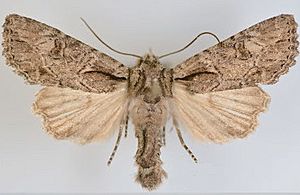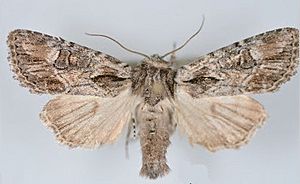Paraseptis facts for kids
Quick facts for kids Paraseptis |
|
|---|---|
 |
|
| Male | |
 |
|
| Female | |
| Scientific classification | |
| Kingdom: | |
| Phylum: | |
| Class: | |
| Order: | |
| Family: | |
| Genus: |
Paraseptis
Mustelin & Crabo, 2015
|
| Species: |
P. adnixa
|
| Binomial name | |
| Paraseptis adnixa (Grote, 1880)
|
|
| Synonyms | |
|
|
The Paraseptis adnixa is a type of moth. It belongs to a group of moths called Noctuidae. This moth is the only species in its genus, Paraseptis. Scientists Tomas Mustelin and Lars G. Crabo named this genus in 2015. The moth was first described by Augustus Radcliffe Grote in 1880. You can find Paraseptis adnixa along the Pacific Coast. It lives in many different forest areas, from northern Mexico all the way to south-western British Columbia.
What They Look Like
The Paraseptis adnixa moth has a wingspan of about 32 to 37.5 millimeters. This is about the length of two paper clips. Adult moths are usually gray-brown. They have many dark lines and spots on their wings. They also have a lighter patch on their wings called a postreniform patch.
Their back wings, called hindwings, often look streaky. You can also see dark veins running through them. The moth has a thick black line at the base of its wing. This line is called a basal dash. It is thicker and longer than the one on the Aseptis binotata. Paraseptis adnixa also has clear black wedge shapes on its wings.
In the Pacific Northwest, these moths often look patchy brown. They sometimes have a reddish color. They also have a large, pale yellow patch and strong black markings. Adult moths are active from April to July.
What They Eat
The young moths, called larvae, eat leaves from certain plants. They feed on Oemleria cerasiformis and different types of Prunus species. Prunus includes plants like cherries and plums.
About the Name
The name of the genus, Paraseptis, comes from two parts. "Para" means "next to" or "beside." "Septis" is similar to the name of another moth genus, Aseptis. So, the name means "next to Aseptis."
See also
 In Spanish: Paraseptis para niños
In Spanish: Paraseptis para niños

